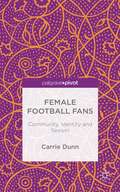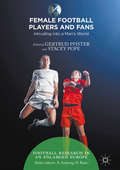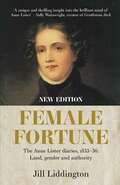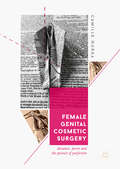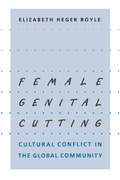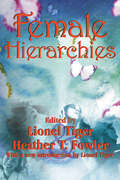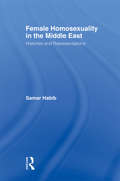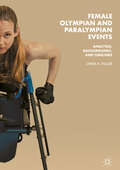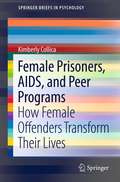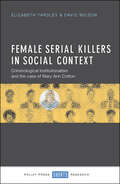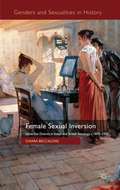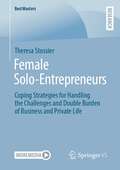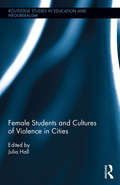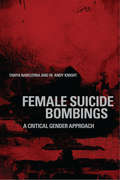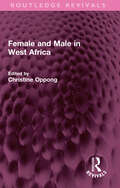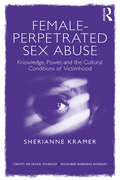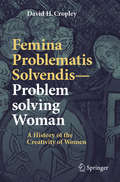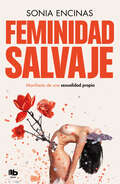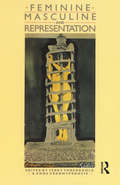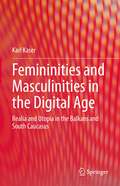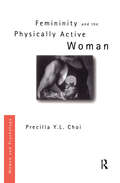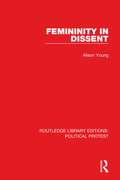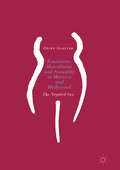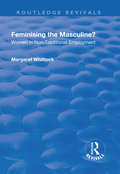- Table View
- List View
Female Football Fans: Community, Identity and Sexism
by Carrie DunnMost sociological work on football fandom has focused on the experience of men, and it usually talks about alcohol, fighting and general hooliganism. This book shows that there are some unique facets of female experience and fascinating negotiations of identity within the male-dominated world of men's professional football.
Female Football Players and Fans
by Gertrud Pfister Stacey PopeThis volume draws upon social science and historical approaches to provide insights into the world of women’s football and female fans. It gives an in-depth analysis of the development of the women’s game in different European countries and examines the experiences of female fans. An overview about women’s football in Europe shows the rise and development of the game and the increasing inclusion of girls and women in football and fan communities. To date, there has been a lack of research on female participation in football, but drawing on research studies from various European countries, the volume explores a range of issues, including how girls and women become football fans and players, how women combine football with their everyday lives, and how they may encounter stereotypes and barriers when they challenge male dominance by entering this traditionally male sport. This collection will be of interest to students and scholars in a range of fields, including sports sociology, sport sciences, gender studies, leisure studies, women’s studies as well as fandom and cultural studies.
Female Fortune: The Anne Lister Diaries, 1833-36: Land, Gender and Authority
by Jill LiddingtonFemale Fortune is the book which inspired Sally Wainwright to write Gentleman Jack, now a major drama series for the BBC and HBO. <p><P> Lesbian landowner Anne Lister inherited Shibden Hall in 1826. She was an impressive scholar, fearless traveller and successful businesswoman, even developing her own coal mines. Her extraordinary diaries, running to 4-5 million words, were partly written in her own secret code and recorded her love affairs with startling candor. The diaries were included on UNESCO’s Memory of the World Register in 2011. <p><P> Jill Liddington’s classic edition of the diaries tells the story of how Anne Lister wooed and seduced neighbouring heiress Ann Walker, who moved in to live with Anne and her family in 1834. Politically active, Anne Lister door-stepped her tenants at the 1835 Election to vote Tory. And socially very ambitious, she employed architects to redesign both the Hall and the estate. <p><P> Yet Ann Walker had an inconvenient number of local relatives, suspicious of exactly how Anne Lister could pay for all her grand improvements. Tensions grew to a melodramatic crescendo when news reached Shibden of the pair being burnt in effigy. <p><P> This 2022 edition includes a fascinating Afterword on the recent discovery of Ann Walker’s own diary. Female Fortune is essential reading for those who watched Gentleman Jack and want to know more about the extraordinary woman that was Anne Lister.
Female Genital Cosmetic Surgery: Deviance, Desire and the Pursuit of Perfection
by Camille NurkaExamining the fascinating history of female genital cosmetic surgery, Camille Nurka traces the origins of contemporary ideas of genital normality. Over the past twenty years, Western women have become increasingly worried about the aesthetic appearance of their labia minora and are turning to cosmetic surgery to achieve the ideal vulva: a clean slit with no visible protrusion of the inner lips. Long labia minora are described by medical experts as ‘hypertrophied,’ a term that implies deformity and the atypical. But how far back does the diagnosis of labial hypertrophy go, and where did it originate? Female Genital Cosmetic Surgery tells the story of the female genitalia from the alien world of ancient Greek gynaecology to the colonial period of exploration and exploitation up to the present day. Bringing together historical, medical, and theoretical documentation and commentary, Nurka uncovers a long tradition of pathologizing female anatomy, a history sure to be of interest to any reader who wishes to know more about how medicine shapes our commonly held ideals.
Female Genital Cutting: Cultural Conflict in the Global Community
by Elizabeth Heger BoyleThe practice of female genital cutting, sometimes referred to as female circumcision and common in a number of African states, has attracted increasing attention in recent years and mobilized strong international opposition. While it typically produces a visceral response of horror and revulsion in Westerners, the practice is widely regarded in some cultures as essential for proper development into womanhood and is defended by women who have themselves experienced it and who have had the procedure performed on their own daughters. It is also perceived in many Islamic communities as religiously prescribed, although most Islamic clerics do not condone the practice.In this study, sociologist Elizabeth Boyle examines this controversial issue from the perspectives of the international system, governments, and individuals. Drawing on previous scholarship, records of international organizations, demographic surveys, and the popular media, Boyle examines how the issue is perceived and acted upon at international, national, and individual levels. Grounding her work in the sociological theory of neoinstitutionalism, Boyle describes how the choices made by governments and individual women are influenced by the often conflicting principles of individual human rights and sovereign autonomy. She concludes that while globalization may exacerbate such conflicts, it can ultimately lead to social change.
Female Hierarchies
by Lionel TigerDisproportionate attention has long been paid to males in human and other social systems. The basic structures used to explain social behavior in sociological and biological work have overwhelmingly emphasized the significance and shape of male behavior and far less female behavior which is surely at least as important. Stratification, sexual selection, and natural selection of what women do among themselves and how they relate to men was explored in this volume for the first time. It is now available in a paperback edition, with a new introduction by Lionel Tiger. Do females conduct aggressive encounters with each other? Or do they have no impact on mate selection and hence on the future of the genotype? Is the main negotiation of females with males and not among themselves during this selective process? Do the usually larger size and frequently more elaborate behavioral displays of males betray the fact that the burden of selective functioning falls on males and not on females? It is improbable that the answer to these questions is "yes" and that there is little or nothing happening in all-female groups that affects not only how their communities operate but, more importantly in the long run, the genotype of their species. For those species in which gregarious social behavior is a sine qua non for successful reproduction, what are the principles of selection that operate through females? Are female hierarchies more abrasive or generous than male ones? Do they focus more on reproduction than production? What are the forms of female social grouping that either support, modify, inhibit, or stimulate sexual and hence natural selection? This work goes far beyond the slogans of our time for important responses to basic questions.
Female Homosexuality in the Middle East: Histories and Representations (Routledge Research in Gender and Society)
by Samar HabibThis book, the first full-length study of its kind, dares to probe the biggest taboo in contemporary Arab culture with scholarly intent and integrity - female homosexuality. Habib argues that female homosexuality has a long history in Arabic literature and scholarship, beginning in the ninth century, and she traces the destruction of Medieval discourses on female homosexuality and the replacement of these with a new religious orthodoxy that is no longer permissive of a variety of sexual behaviours. Habib also engages with recent "gay" historiography in the West and challenges institutionalized constructionist notions of sexuality.
Female Olympian and Paralympian Events: Analyses, Backgrounds, and Timelines
by Linda K. FullerFemale Olympian and Paralympian Events is a groundbreaking book that examines women’s sports in the Olympic and Paralympic Games, which have long been underappreciated and under-analyzed. The book begins with a brief background on women’s participation in the Olympic Games and their role relative to the International Olympic Committee, then introduces the underlying Gendered Critical Discourse Analysis theory used throughout the book’s analysis before delving into a literature review of female Olympians and Paralympians’ events. It includes a listing of noteworthy “firsts” in the field, followed by individual discussions of twenty-eight Summer and seven Winter events, analyzed according to their historical, rhetorical, and popular cultural representations. Women’s unique role(s) in the various events are discussed, particular athletes and Paralympic events are highlighted, and original tables are also included. At the end of each section, affiliated organizations and resources are included in this invaluable referential volume.
Female Prisoners, AIDS, and Peer Programs
by Kimberly CollicaThis book highlights a neglected area in the field of rehabilitation of female offenders with AIDS. It provides data to show how women, working as HIV peer educators in prison, utilize their peer experiences as a transition point for rehabilitation both inside and outside of the penitentiary. HIV and prison are inextricably linked and education has proved to be the one constant that mitigates the spread of both HIV and crime. Research on female inmates in general is not frequent and this book presents unique qualitative data that includes rich accounts from the women themselves. It illustrates the benefits derived by female inmates who work in an HIV prison-based peer program, while adding to the criminology literature on female patterns of criminality and rehabilitation. It provides a greater understanding of how prison programs affect the processes of criminal desistance and behavioral changes for female inmates. Women involved in such programming are able to change the criminal trajectory of their life direction. contributing to reduced levels of recidivism and institutional disciplinary infractions. The implications for these programs is relevant within the broader perspective of women, HIV and incarceration.
Female Serial Killers in Social Context: Criminological Institutionalism and the Case of Mary Ann Cotton
by David Wilson Elizabeth YardleyTo date, approaches to understanding serial murder have focused on individual cases rather than the social context in which they occurred. Written by leading criminologists and world experts on serial murder, this book marks a departure by situating nineteenth century serial killer Mary Ann Cotton within the broader social structure. Using archival records of her court appearances, local histories and newspaper articles, it uniquely explores how institutions such as the family, economy and religion shaped the environment she inhabited and her social integration through the roles of wife, mother, worker and criminal. Acknowledging that it takes a particular type of individual to commit serial murder, the book shows that it also takes a particular type of society to enable that murderer to go unseen. As the first work to analyse serial murder through the theoretical framework of institutional criminology and institutional anomie theory, it will equip criminologists with a methodological toolkit for performing institutional analysis.
Female Sexual Inversion
by Chiara BeccalossiBetween the end of the nineteenth and the beginning of the twentieth centuries, a number of women were diagnosed as sexual inverts in Britain and Europe. This book examines the ways in which female same-sex desires were represented across a wide range of Italian and British medical writings during this period. Chiara Beccalossi has undertaken extensive archival research to bring to light new documents and give a detailed account of how the female invert was positioned alongside other figures of same-sex desires, such as the tribade-prostitute, the fiamma (flame), the nymphomaniac, and women with abnormal genitalia or bodily dysfunctions. In this way this book shows the richness of medical representations of female same sex-desires that has previously been unexplored in historical scholarship.
Female Solo-Entrepreneurs: Coping Strategies for Handling the Challenges and Double Burden of Business and Private Life (BestMasters)
by Theresa StossierAustria’s economy is characterized through small and medium sized enterprises. Solo entrepreneurs are considered a special form within SMEs and contribute a major share to Austrian’s economy besides being Austria’s most popular legal form of organization within the micro firms. In 2020 every second of Carinthia’s start-up businesses was established by a female entrepreneur. According to an entrepreneurship study presented by Volksbank in 2019, nearly half of all female entrepreneurs lived with children and juveniles. Two-thirds of women said they were solely responsible for family, childcare, and household and 71 percent of those female entrepreneurs specified that those circumstances caused difficulties for them. This book investigated Carinthian female solo entrepreneurs and aims to find out how these hard-working women manage their business and private life while contributing to such great extent to the (federal) state’s economy. The conceptual foundations were found in embeddedness and the contextual framework which supports the importance of numerous influences on different levels placed on the entrepreneur. The empirical section represents a primary research that evaluates self-collected data sets of Carinthian solo-entrepreneurs.
Female Students and Cultures of Violence in Cities (Routledge Studies in Education, Neoliberalism, and Marxism #9)
by Julia HallAs the economy constricts, it seems living with a chronic sense of fear and anxiety is the new normal for a growing number of urban females. Many females are susceptible to victimization by cumulative strands of violence in school, their communities, families and partnerships. Exposure to violence has been shown to contribute to physical and mental health problems, a propensity for substance abuse, transience and homelessness, and unsurprisingly, poor school attendance and performance. What does a girl do when there is no place to get away from this, and even school is a danger zone? Why have so many educators turned their attention away from the reality of violence against girls? Why is there a tendency to categorize such violence as just another example of the general concept of "bullying?" Critical educators who research the effects of current market logics on the schooling of marginalized youth have yet fully to focus on this issue. This volume puts the reality of violence in the lives of urban school girls back on the map, investigates answers to the above questions, and presents suggestions for change.
Female Suicide Bombings: A Critical Gender Approach
by Tanya Narozhna W. Andy KnightAs media coverage of terrorism and terroristic acts has increased so too has the discussion about the identities, motives, and gender of the perpetrators. Over the past fifteen years, there have been over 150 reported suicide bombings committed by women around the world. Because of its prominence in media reporting, the phrase "female suicide bomber" has become loaded with gendered notions and assumptions that elicit preconditioned responses in the West. Female Suicide Bombings critically examines and challenges common assumptions of this loaded term. Tanya Narozhna and W. Andy Knight introduce female suicide bombings as a socio-political practice and a product of deeply politicized, gendered representations. Drawing on a combination of feminist and post-colonial approaches as well as terrorism studies literature, the authors seek to transcend ideological divisions in order to enhance our understanding of how gender, power, and academic practices influence our perceptions of female suicide bombings.
Female and Male in West Africa (Routledge Revivals)
by Christine OppongIn the 1970s and early 1980s, there was a lack of contemporary, readily available studies of the informal relationships between the sexes; their day to day activities and expectations and how these were altering; especially in contexts in which there were radical demographic, political and economic changes taking place. Originally published in 1983, this volume documents the complexities and subtleties of the modes of interaction between women and men in one region of Africa. It seeks to provide insights and understanding of changing social contexts and relationships based upon ethnographic field work carried out in the previous decade. There are five sections. The first is comparative; presenting and analysing statistical data from the countries of the region; including demographic profiles of fertility, migration, mortality, as well as census and survey evidence on work patterns and education. It provides the broad framework within which the individual case studies are located. The theme of the first set of case studies is the traditional separation and interconnectedness apparent in the worlds of women and men in several culture areas in the spheres of arts and crafts, music, political roles, language, symbolism, ritual, domestic organization and resources and sexuality. The second set focuses on the theme of domestic cooperation and conflict, in production and consumption – in particular the conflicting claims and expectations of men and women, as spouses and kin. The third set of essays is concerned with the relative resources and opportunities of females and males in schools and employment contexts, in sexual encounters and in national community and domestic decision-making processes. The subjects of the final section include individualism, autonomy and dependence of the members of one sex upon the other. The increased individualism, resulting from migration and the scattering of kin, and the breakdown of cooperative work patterns between spouses and relatives is seen as leading to instances of both increased dependence on the one hand, especially of women on men, and increased opportunities for economic autonomy on the other. The case studies span a wide range of socio-economic conditions including studies of farmers, traders, fishermen and fishmongers, factory and office workers, the relatively rich and the relatively poor, from many different ethnic groups and six countries. The book was expected to be of interest to a wide range of readers in social science disciplines as well as to planners and administrators. It should still prove to be particularly relevant to the needs of university students in the fields of women’s studies, African studies, Black studies, sex roles, family relations, sociology and anthropology.
Female-Perpetrated Sex Abuse: Knowledge, Power, and the Cultural Conditions of Victimhood (Concepts for Critical Psychology)
by Sherianne KramerFemale-Perpetrated Sex Abuse is a groundbreaking study into gender, sexuality and victimhood. It examines the cultural conditions of possibility for FSA victimhood as a means to advance contemporary critical understandings of the role of gender and sexuality as instruments of modern power. As the first direct exploration of FSA victimhood, this book analyses: why victims of FSA remain so underexplored and invisible as objects of human science knowledge; the limited and overly rigid discourses in local and global psychological theory and practice that continues to treat particular subjects as ‘victim worthy’ through paradigms that construct victimhood as gendered; and the possibility of new discourses that could disrupt normative understandings of gender, sexuality, and power in sex abuse, and as constitutive to the beginnings of a counter-knowledge on transgressive sexualities. By tracing the historical and cultural conditions of the emergence of FSA broadly and FSA victimhood specifically, Kramer illustrates how deeply engrained constructions of gender and sexuality both produce and constrain the possibilities for reporting, disclosing and self-identifying victimhood. Female-Perpetrated Sex Abuse is essential reading for academics, researchers and students alike, in the areas of psychology, sociology, gender studies, criminology, counselling and social work.
Femicide, Gender and Violence
by Daniela BandelliThis book questions gendered readings of violence by analyzing how this paradigm has become normalized in Italy since the feminist term 'femminicidio', or 'femicide', entered the mainstream media during the 2013 general election. It also sheds light on discourses of contestation on the part of family activists, men's rights campaigners and divorced fathers' groups. Two counter-discourses emerge. The first is what the author terms an 'ideology narrative', for which discourses built around the conceptual category of 'gender' normalize simplistic representations of relationships between men and women. The second is a 'female violence discourse', which sheds light on under-represented aggressor-victim relations and modifies dominant representations of femininity and masculinity. The author argues that integrating these two discourses into public debates helps to reappropriate the complexity and biological dimensions of (violent) relationships between men and women, often overshadowed by gender/feminist perspectives. In this way, she concludes, we can address neglected social issues that contribute to violence beyond gender. This thought-provoking book will appeal to students and scholars of sociology, critical discourse studies and gender.
Femina Problematis Solvendis—Problem solving Woman: A History of the Creativity of Women
by David H. CropleyThis book explores the history of modern human creativity/innovation, highlighting examples of solutions to basic human’ needs that have been developed over time. The title – Femina Problematis Solvendis – is a play on the scientific classifications of humans (Homo habilis, Homo erectus, Homo sapiens), but with special focus on inventions pioneered by women (“femina”) and is intended to suggest that a defining characteristic of modern humans is our fundamental ability to solve problems (i.e., problem-solving woman = Femina problematis solvendis), Written by David H. Cropley, an internationally recognised expert on creativity and innovation, it also builds on his previous book “Homo Problematis Solvendis –Problem-solving Man”, published in 2019. The book explores innovations over ten distinct “ages” of human history, beginning with “prehistory”, and moving up to the present “information age”. Each era is covered by a dedicated chapter that describes three key innovations that were either definitely invented by a woman or can be plausibly attributed to a female inventor. The book’s focus on female inventors also serves to highlight some of the ways women have been treated in societies over time.
Feminidad salvaje: Manifiesto de una sexualidad propia
by Sonia Encinas¿Te has preguntado por qué vives la sexualidad como lo haces? ¿Qué significa para ti gozar? Con Feminidad salvaje, la sexóloga Sonia Encinas nos invita a abrir una caja de Pandora que lleva demasiado tiempo enterrada y a unirnos a una revolución que no necesita ni pancartas ni barricadas. Esta tiene lugar en lo más íntimo, en nuestra propia cama, en nuestro propio cuerpo, en nuestros propios ritmos sexuales y en la definición propia de la feminidad. Se trata de una sublevación ante lo que nos dijeron que debíamos ser y de una transformación que nos conecta con nuestra esencia más salvaje, aquello que no podemos (ni debemos) domar. Un camino hacia la mujer sexual que somos. Para recuperarnos, liberarnos y gozar. Sonia Encinas, con su gran habilidad para comunicar, se desnuda ante la lectora y, a través de su propia historia –a la vez tan personaly universal–, la guía para reconectar consigo misma, con su cuerpo, con sus emociones y creencias, para redescubrir sin pudor su propia sexualidad. Un libro que habla sobre el sexo, el amor, las relaciones, el respeto, los cuidados, la sororidad y el feminismo. «Mujer salvaje, que el placer sea tu brújula».
Feminine/Masculine and Representation
by Terry Threadgold; Anne Cranny-FrancisFeminine/Masculine and Representation provides a much needed introduction to a number of challenging issues raised in debates within gender studies, critical theory and cultural studies. In analysing cultural processes using a range of different methods, the essays in this collection focus on gender/sexuality, representation and cultural politics across a variety of media.
Femininities and Masculinities in the Digital Age: Realia and Utopia in the Balkans and South Caucasus
by Karl KaserThis book provides a fresh overview on the debate about the remarkable regression of gender equality in the Balkans and South Caucasus caused by the fall of socialism and by the revitalization of religion in Turkey. Contrary to the prevailing opinion of researchers who state continuous male domination, the book presents strong arguments for an alternative outlook. By contrasting the realia of gender relations with the utopia of new femininities and new masculinities driven by digital visual communication, the book provokingly concludes with the arrival of two utopias: the Marlboro Man – still authoritative but lonely – conquering and refusing family obligations; and with the emergence of a new femininity type – strong and beautiful. As such this book provides a great resource to anthropologists, demographers, sociologists, gender and media researchers and all those interested in feminist issues.
Femininity and the Physically Active Woman (Women And Psychology Ser.)
by Precilla Y. ChoiThe fitness boom of the last two decades has led to many people incorporating exercise into their lifestyles through activities such as jogging and aerobics. However, whilst many physical and psychological health benefits have been documented, far too few people actually take part in enough exercise to glean significant improvements, and this is much more a problem for women than men.Femininity and the Physically Active Woman explores one reason many women offer for their lack of involvement in sport and exercise - that they are not the 'sporty' type. Precilla Y.L. Choi argues that the 'sporty' type is masculine, and to determine how this notion might affect women's self-perceptions, she critically examines the experiences of women athletes, bodybuilders, recreational exercisers and girls' physical education. What emerges is the importance of visible differences between women and men, in terms of muscularity, strength and agility in order to maintain the gender order. Thus, if a girl or woman wishes to play the masculine game of sport she must do so in conformity with a number of patriarchal rules which ensure she is first and foremost recognised as a heterosexual feminine being.Contributing to a psychology of the physically active woman by examining women's experiences from critical feminist and gendered perspectives, Femininity and the Physically Active Woman will be of great interest to students, researchers, practitioners and teachers from a range of disciplines.Precilla Y.L. Choi is the British Association for the Advancement of Science's Joseph Lister Lecturer for 2000. She has co-edited, with Paula Nicolson, Female Sexuality (Prentice Hall).
Femininity in Dissent (Routledge Library Editions: Political Protest #8)
by Alison YoungThis book, first published in 1990, takes a challenging look at the images constructed by the Press of women's political protest. Focusing on the peace camp at Greenham Common, Alison Young analyses in detail the way in which women protestors are represented in the press as deviant and criminal. Arguing that the criminal justice system and the media rely on each other's definitions of deviance, she investigates in detail how those definitions are constructed and encoded. In the course of her analysis she utilizes concepts of narrative structure, metaphor, the body, the cultural unconscious, and mental as well as social instability. The first and only full-length study of its kind, Femininity in Dissent takes an interdisciplinary approach, questioning traditional methods of criminology and sociology of deviance, and drawing on literary theory, women’s studies and social theory. In articulating cultural forms of regulation and social control, the author provides an analysis of discourse and deviance.
Femininity, Masculinity, and Sexuality in Morocco and Hollywood
by Osire GlacierThis book is the first to formulate an ideology of emancipation for women in Morocco. Beginning with constructs of the body, femininity and masculinity, it analyzes the central role played by the sociopolitical writing of sexuality in creating gender hierarchy. The author focuses on Morocco, while drawing parallels with Hollywood cinema, one of the great producers of femininity and masculinity, and conducts an exhaustive examination of constructs of femininity and masculinity in language, social practices, cultural productions and legal texts. The objectives of this project are tripartite: it exposes the dynamics that devalue women's humanity; it charts the schemas of their sexual, economic and sociopolitical exploitation; and it advances concrete solutions for re-establishing women's human dignity.
Feminising the Masculine?: Women in Non-traditional Employment (Routledge Revivals)
by Margaret WhittockThis title was first published in 2000: This work aims to provide a comparative and temporal assessment of the position of women in non-traditional employment in Europe, Britain and Northern Ireland. Its second aim is to provide a new perspective on the division of labour in modern Western societies and to critically examine the issues, debates and perspectives which have traditionally dominated portrayals of women and paid employment. The book assesses the potential which women themselves have for transforming existing gender relations, particularly within the structural constraints of the education, training and employment systems. In so doing, it is intended to highlight flaws inherent in much contemporary feminist theorizing, and aims to provide a more satisfactory theoretical framework within which to elaborate and develop its arguments. While related texts have tended to concentrate on stereotypical notions of women and paid employment, this book aims to fill a gap in the literature by scrutinizing the lived experiences of women in non-traditional manual occupations, and relating these to a possible transformation of the existing gender order in Western societies
